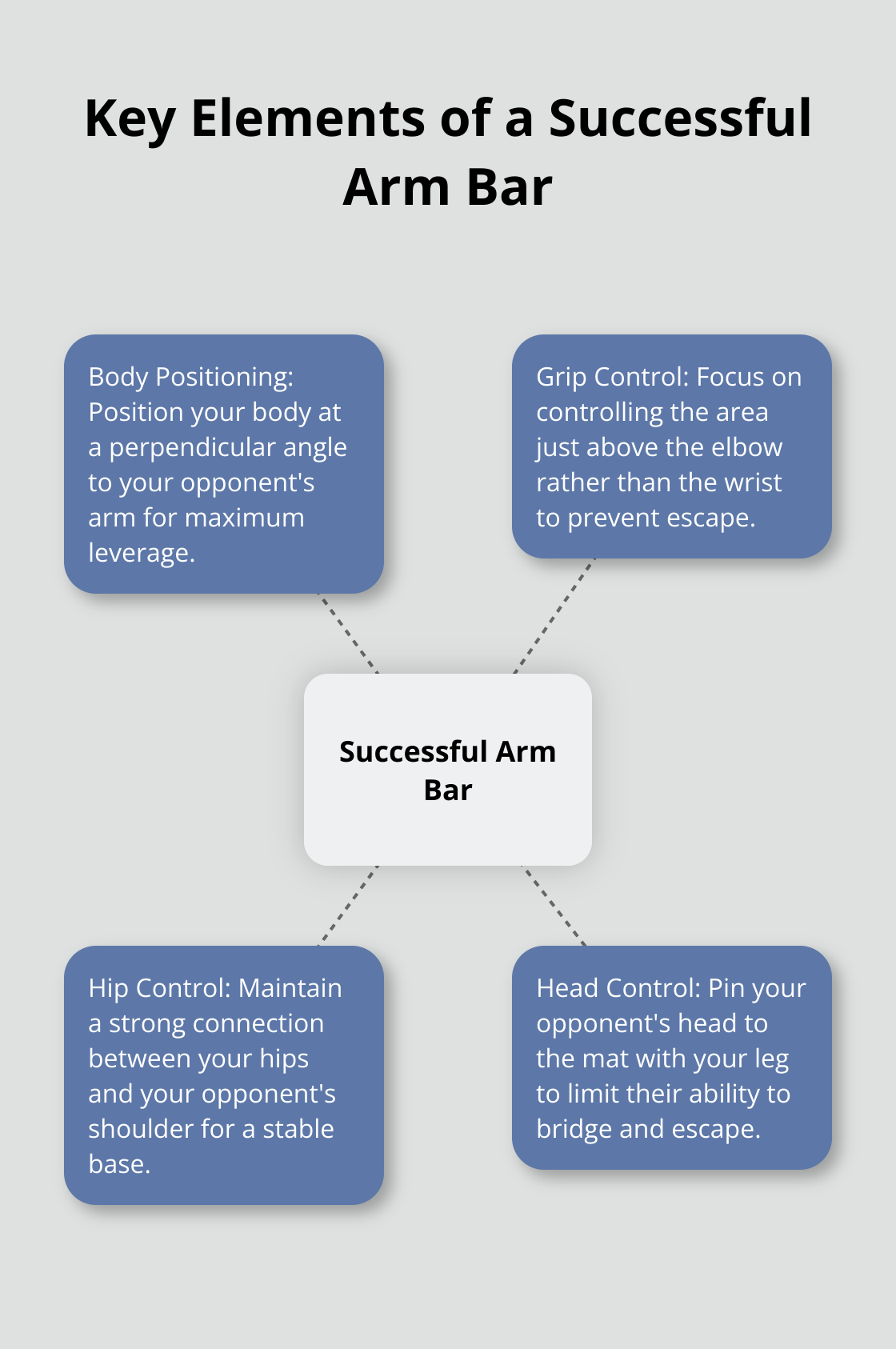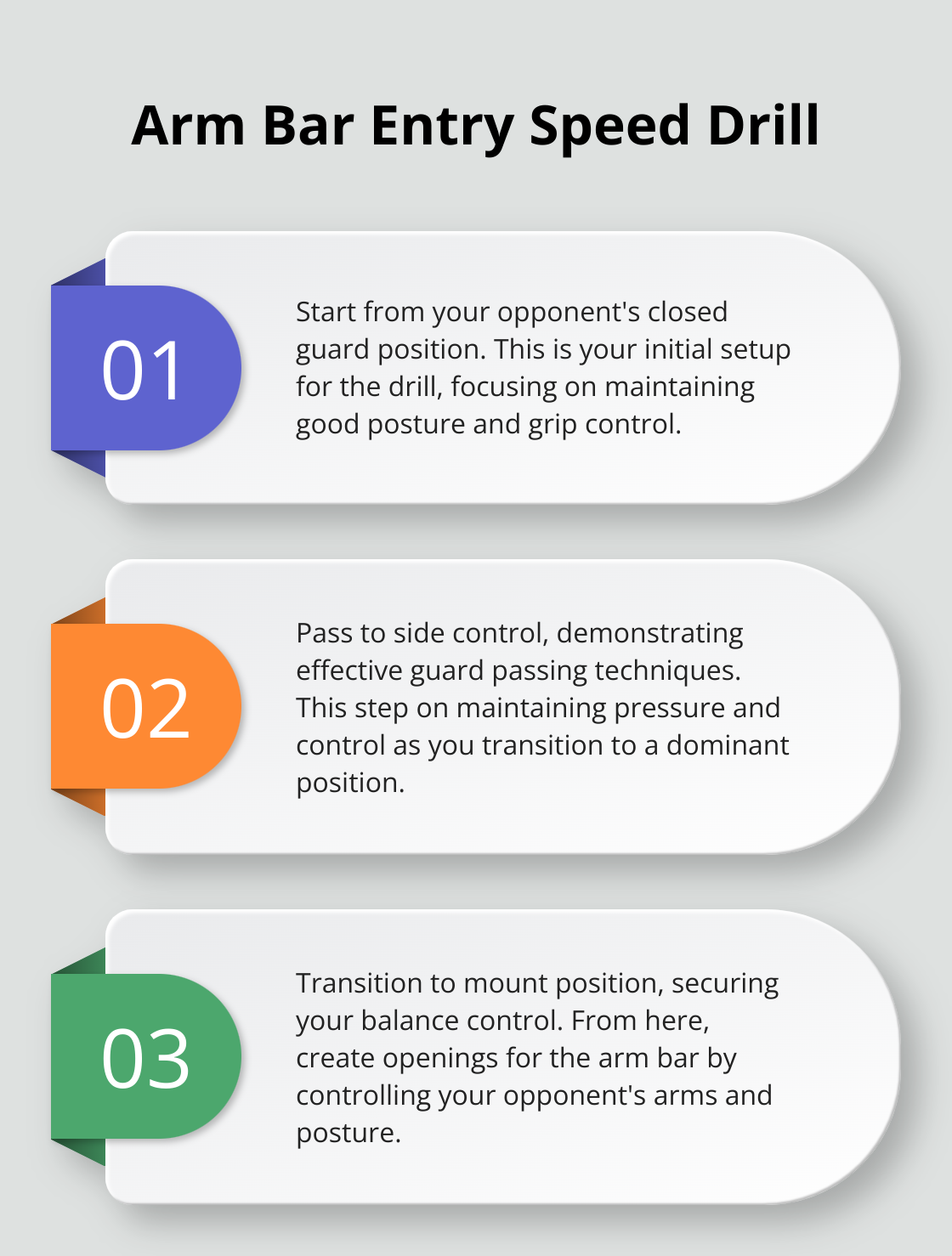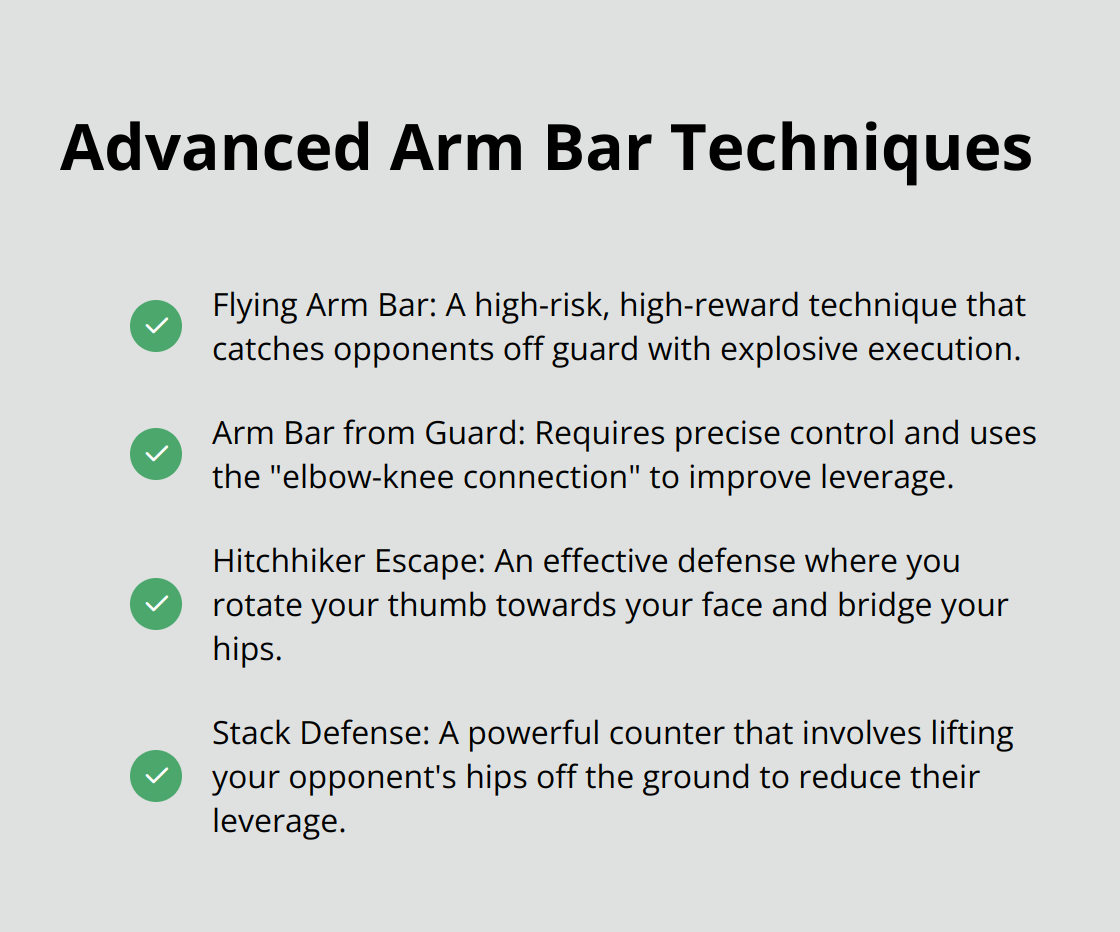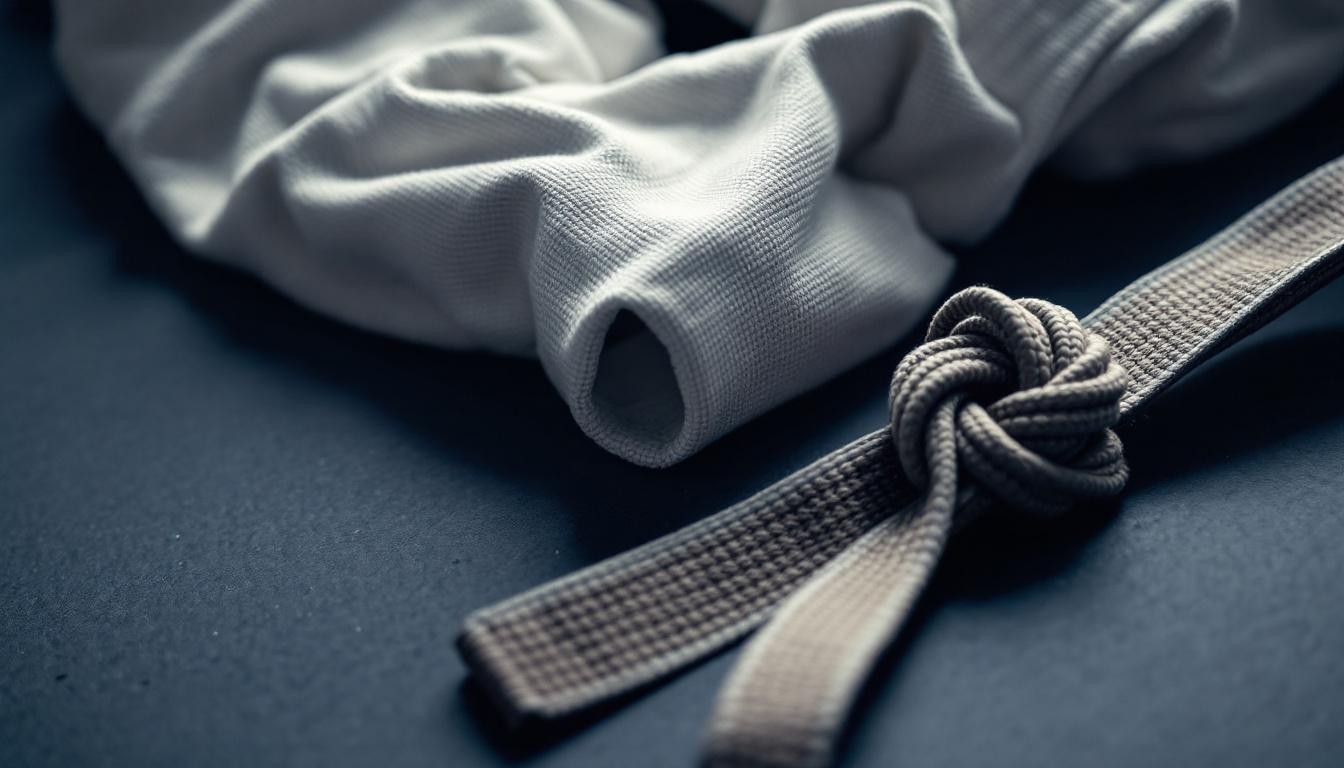At Jiu Jitsu, we’re excited to share our expertise on one of the most iconic techniques in our sport: the arm bar.
This powerful submission has been a game-changer for countless practitioners, from beginners to world champions.
In this post, we’ll break down the key elements of a perfect arm bar in Jiu Jitsu, covering everything from body positioning to advanced variations.
Get ready to elevate your arm bar game and add a lethal weapon to your arsenal.
Mastering the Armbar Mechanics
Positioning for Power
The armbar stands as a cornerstone technique in Jiu-Jitsu. To maximize leverage, position your body at a perpendicular angle to your opponent’s arm. This alignment allows you to apply direct pressure to the elbow joint. Squeeze your legs tightly together, trapping your opponent’s arm between your thighs. Raise your hips slightly off the ground to create a fulcrum point that amplifies the pressure on the joint.
Avoiding Common Pitfalls
Many practitioners grip the arm incorrectly. Focus on controlling the area just above the elbow (rather than the wrist). This grip prevents your opponent from rotating their arm and escaping. Another frequent error occurs when you fail to control the opponent’s head. Pin their head to the mat with your leg to limit their ability to bridge and escape.
Hip Control: The Foundation of Success
Hip control forms the foundation of a successful armbar. Maintain a strong connection between your hips and your opponent’s shoulder to create a stable base for the submission. This connection also allows you to adjust your position quickly if your opponent attempts to escape. Practice bridging your hips upward while maintaining this connection to increase the effectiveness of your armbar.
Refining Your Technique
Expert trainers can provide personalized feedback to help you refine your technique and avoid common mistakes. Try to dedicate significant time to drilling these fundamental aspects of the armbar. Focus on these key elements to develop a formidable armbar in your Jiu-Jitsu arsenal.

Transitioning to Advanced Setups
As you master the basic mechanics of the armbar, you’ll find yourself ready to explore more advanced setups and variations. The next section will guide you through effective transitions from common positions, helping you create and exploit openings for the armbar with increased efficiency.
Setting Up the Perfect Armbar
Mastering Transitions from Guard
The guard position offers excellent opportunities for armbar setups. Control your opponent’s posture by gripping their sleeve and collar. When they attempt to posture up or pass, use your legs to disrupt their balance. This control allows you to swiftly swing your hips out and execute the armbar.
Exploiting Openings from Mount
Mount position presents prime armbar opportunities, especially when opponents defend against other attacks. If they push your hips to create space, trap one of their arms against their body. Slide your knee up towards their head on the trapped arm side, then quickly swing your other leg over their face. This rapid transition often surprises opponents, giving you an ideal armbar position.
Speed and Precision Drills
Incorporate specific drills to improve your armbar entry speed. Start from your opponent’s closed guard, pass to side control, transition to mount, and execute the armbar. Repeat this sequence continuously for 3-5 minutes, focusing on smooth, efficient movements. This drill (recommended by world champion Marcelo Garcia) develops muscle memory and enhances overall grappling flow.

Creating Opportunities
Successful armbar setups require vigilance during rolls. It involves controlling an opponent’s arm and hyperextending their elbow joint to secure a tap or break, capitalizing on the opponent’s mistakes. Look for moments when they overextend their arms or leave them unprotected. These brief windows of opportunity (often lasting only a split second) can lead to a successful armbar submission.
Refining Your Technique
At Souza Grappling Co., our expert trainers provide personalized feedback to help you refine your armbar technique. We focus on smooth transitions, proper body positioning, and timing to maximize your success rate. Regular practice with guidance from experienced instructors will significantly improve your armbar game.
As you master these setup techniques, you’ll find yourself ready to explore more advanced armbar variations. In the next section, we’ll dive into some high-level armbar techniques that will take your Jiu-Jitsu game to new heights.
Advanced Armbar Techniques
The Flying Armbar: High-Risk, High-Reward
The flying armbar catches opponents off guard with its explosive execution. This technique works best when your opponent stands and you grip their sleeve. To perform, pull their arm down while jumping to wrap your legs around their head and arm. As you fall back, control their arm and extend it for the submission.
Marcelo Garcia (world-renowned grappler) stresses the importance of timing in flying armbars. He advises practitioners to practice with a cooperative partner before attempting it in live sparring or competition. Start with slow, controlled movements and increase speed as you become more comfortable with the mechanics.
Maximizing Control from Guard
The armbar from guard requires precise control for effectiveness. To enhance control, break your opponent’s posture by pulling them close with your legs and grips. Use your hips to create angles, making it difficult for your opponent to defend.
John Danaher (BJJ black belt and instructor) recommends the “elbow-knee connection” to improve control. This technique your elbow tight to your opponent’s knee on the attacking side. This connection limits their ability to posture up or pull away, providing better leverage for the submission.
Defending and Countering Armbars
Understanding armbar defenses proves essential for any grappler. The “hitchhiker escape” offers an effective defense. Rotate your thumb towards your face and bridge your hips to create space. This movement allows potential position reversal or escape to safety.
The “stack defense” provides another powerful counter. Lift your opponent’s hips off the ground to reduce their leverage. This action can lead to a pass or even a submission if executed correctly.
Integrating Advanced Techniques
To incorporate these advanced armbar variations into your game, practice consistently and patiently. Drill each technique slowly, focusing on proper form and control. As you improve, gradually increase the speed and resistance of your training partner.
The key to mastering these techniques lies in understanding the underlying principles of leverage, timing, and control. Honing these skills will improve your armbar game and enhance your overall grappling ability.

At Souza Grappling Co., our expert trainers guide students through various scenarios (including these advanced techniques), helping them develop instinctive responses to armbar attempts. Our 3,000 sq. ft. facility provides ample space for practicing these techniques safely and effectively.
Final Thoughts
The arm bar in Jiu-Jitsu demands dedication and practice to master. We explored key elements of body positioning, common mistakes, and the role of hip control in executing a successful arm bar. Our expert trainers at Souza Grappling Co. provide personalized feedback to help you refine your technique and avoid pitfalls.
Advanced variations like the flying arm bar add depth to your game and increase your versatility as a grappler. Understanding defenses against arm bar attempts will make you a well-rounded practitioner. The arm bar opens up other submission and positional opportunities as you become more comfortable with the technique.
Souza Grappling Co. offers expert guidance to help you perfect your arm bar Jiu-Jitsu technique. Our facility and experienced trainers create an ideal environment for skill development. We welcome practitioners of all levels to join our supportive community and reach their full potential on the mats.




